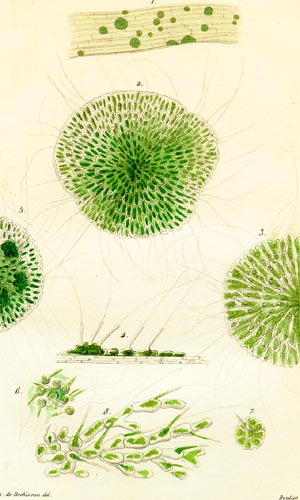Coleochaete Bréb.
Classification: Eukarya, Charophyta, Charophyceae, Coleochaetales, Coleochaetaceae
Synonomy:
Description: Microscopic algae found living on solid surfaces in still or slow moving fresh waters. Composed of branched filaments spreading flat across the substrate or rising in a three-dimensional cushion. In some species the filaments are laterally appressed so tightly that the filamentous nature of the thallus may not be immediately apparent. Cells have a single, parietal chloroplast with one (+) conspicuous pyrenoid. Distinctive sheathed hairs formed by extension of the cell wall and extrusion of a cytoplasmic thread from the sheath formed by the cell wall are present on some or all of the cells of thallus. The hair is closely associatedwith the chloroplast, and in some species the chloroplast of hair cells is positioned sideways and rotates around the base of the hair. Most species are capable of vegetative reproduction by zoospores with two slightly subapical and lateral flagella. Reproduction is oogamous. The vegetative thalli are haploid. The only diploid stage being the zygote, but multiple (16-32) meiospores are typically released from each zygote.
Key Literature: de Brébisson, M.A. 1844. Description de deux nouveaux genres d'algues fluviatiles. Annales des Sciences Naturalles Botanique 3:25-31. Pringsheim, N. 1860. Beiträge zur Morphologie und systematik der Algen: III. Die Coleochaeteen. Jahrbücher für wissenschaftliche Botanik 2:1-38.
Plate from Brebisson 1844, kindly provided by Mike Wynne.
Pictoral overview of reproduction in Coleochaete pulvinata, prepared by Linda Graham and Charles Delwiche



